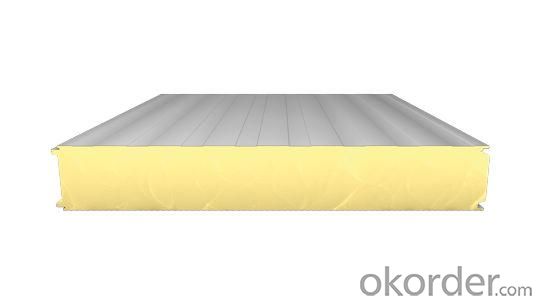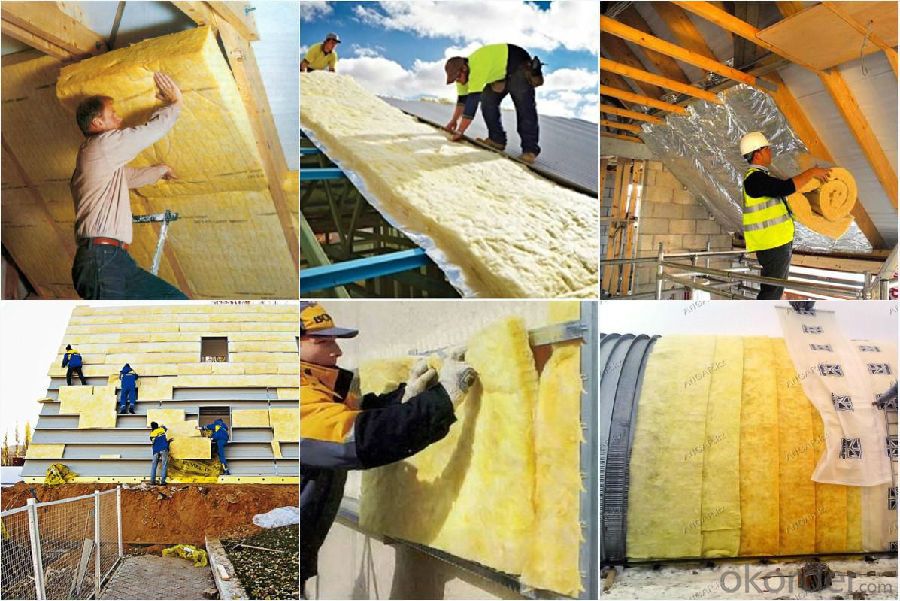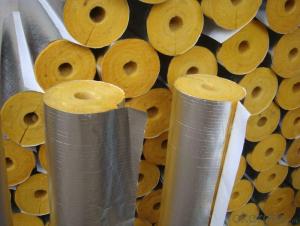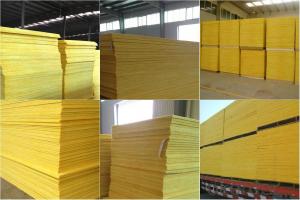heat insulation can be coated with aluminum foil glass wool felt
- Loading Port:
- Tianjin
- Payment Terms:
- TT OR LC
- Min Order Qty:
- 5000 m²
- Supply Capability:
- 20000 m²/month
OKorder Service Pledge
OKorder Financial Service
You Might Also Like
1.Description of Glass Wool Blanket:
Glass wool, which belongs to glass fiber , is a kind of man-made inorganic fiber. It is made from fibrosis glass melt in wool shape, which belongs to inorganic fiber and fiber in its chemical ingredient. Its merit is better in shape, low density and volume, low in thermal conduction, better heat preservation and thermal insulation, fine sound absorption, corrosion-resistant and stable chemical property.
Glass Wool Blanket complete glass wool production lines employing latestgeneration technology to manufacture boards, rolled blankets and pipes for residential and industrial thermal and acoustic insulation needs, in compliance with the top international standards (EN, DIN, ASTM).
At the system HOT END, the raw materials are dosed, mixed, melted, fiberized, impregnated with a special binder and formed into a primitive mat of very fine fiber glass. Continuous conveyors transport the mat to the COLD END of the plant for binder polymerization. The product is then cut to shape and packed for shipping.
2.Main features of Glass Wool Blanket:
• Unique technology; rebound degree after compressive packing is up to 99.2%.
• Soft and long glass fibers can maximally lessen flying catkins in the construction.
• Sound absorption and noise reduction; it can effectively prevent sound from spreading.
• Grade A1 incombustible materials.
• Easy for construction; cutting at will.
• Antisepsis, ageing resistance, and anticorrosion, ensuring a healthy environment.
• Low moisture absorption; stable physical properties.
3.Glass Wool Blanket Images:


4. Glass Wool Insulation Blanket Technical Parameters:
Property | High/low temperature resistance, oil and fuel resistance, weathering resistance, O zone resistance etc. |
Shape | According to your requirement. |
Color | Any color is available ,according to your requirements. |
Material | NBR, CR, SBR, EPDM, IIR, NR, EP, Silicone, VITON etc. |
Hardness | 30-90ShoreA |
Delivery | In 10 days |
Packing | Plastic bag & carton box or according to your requirements. |
Application | Electronic field, industrial machine & equipment, house-hold appliance, telecommunication, automobile, medical equipment industry etc. |


5.FAQ
We have organized several common questions for our clients,may help you sincerely:
①How about your company?
A world class manufacturer & supplier of Glass Wool Blanket is one of the large scale professional investment casting production bases in China,consisting of both casting foundry forging and machining factory. Annually more than 8000 tons Precision casting and forging parts are exported to markets in Europe,America and Japan. OEM casting and forging service available according to customer’s requirement.
②How to guarantee the quality of the products?
We have established the international advanced quality management system every link from raw material to final product we have strict quality test; We resolutely put an end to unqualified products flowing into the market. At the same time, we will provide necessary follow-up service assurance.
- Q:Are there any environmental considerations when using fiberglass mat tissue?
- There are numerous factors to consider in terms of the environment when utilizing fiberglass mat tissue. First and foremost, the production process for fiberglass mat tissue necessitates the consumption of energy and resources. This involves extracting non-renewable raw materials like silica sand, limestone, and soda ash. Furthermore, the energy-intensive procedure of melting these materials at high temperatures contributes to greenhouse gas emissions. In addition, the manufacturing of fiberglass entails the utilization of chemicals such as resins and binders, which can be environmentally harmful if not properly managed. If these chemicals are not handled and disposed of correctly, there is a potential risk of them seeping into water bodies or soil. Moreover, fiberglass mat tissue is not capable of biodegradation. It can take hundreds of years for it to decompose in a landfill. Inadequate disposal of fiberglass mat tissue can lead to environmental pollution and contribute to the ongoing waste management issue. Lastly, the use of fiberglass mat tissue in certain applications, such as insulation or construction, can have implications on energy efficiency. While fiberglass is an effective insulator, its production and installation may require additional energy inputs, such as the use of fossil fuels for transportation or heating during installation. To address these environmental considerations, it is crucial to promote sustainable practices in the production and use of fiberglass mat tissue. This can involve implementing energy-efficient manufacturing processes, reducing the utilization of harmful chemicals, encouraging the recycling or reuse of fiberglass materials, and exploring alternative materials with lower environmental impacts.
- Q:Is fiberglass mat tissue compatible with different adhesives?
- Yes, fiberglass mat tissue is compatible with different adhesives. Fiberglass mat tissue is a versatile material that can be used in various applications such as construction, automotive, and aerospace industries. It is commonly used as a reinforcement material in composites, where it is combined with resin and adhesive to create strong and durable structures. The compatibility of fiberglass mat tissue with different adhesives depends on several factors such as the type of adhesive, the specific application, and the desired performance requirements. Fiberglass mat tissue can be compatible with a wide range of adhesives including epoxy, polyester, vinyl ester, and polyurethane adhesives. It is important to consider the specific properties and characteristics of the adhesive and the fiberglass mat tissue when selecting the adhesive for a particular application. Factors such as curing time, viscosity, bond strength, and chemical resistance should be taken into account to ensure optimal adhesion and performance. In some cases, surface treatment or priming may be necessary to enhance the compatibility between the fiberglass mat tissue and the adhesive. This can involve applying a primer or using a specific surface treatment method to promote adhesion and ensure a strong bond between the two materials. Overall, fiberglass mat tissue is compatible with different adhesives, but it is crucial to consider the specific requirements of the application and select the appropriate adhesive and surface treatment method to achieve the desired results.
- Q:What is the fire rating of fiberglass mat tissue?
- The fire rating of fiberglass mat tissue can vary depending on its specific composition and intended application. However, fiberglass mat tissue typically has a good fire resistance rating due to the inherent properties of fiberglass, such as its high melting point and non-combustible nature. It is often used in fire-rated applications where fire protection is required.
- Q:Does fiberglass mat tissue provide any moisture insulation?
- Yes, fiberglass mat tissue provides some level of moisture insulation. Fiberglass is known for its water-resistant properties, and the mat tissue made from fiberglass helps to further enhance this characteristic. It acts as a barrier against moisture, preventing it from seeping through and causing damage to underlying materials. However, it is important to note that fiberglass mat tissue is not completely waterproof and may allow some moisture to penetrate over time. Therefore, it is recommended to use additional moisture insulation materials in situations where complete waterproofing is required.
- Q:Can fiberglass mat tissue be used for repairing fiberglass jet skis?
- Yes, fiberglass mat tissue can be used for repairing fiberglass jet skis. Fiberglass mat tissue is commonly used in fiberglass repairs as it provides strength and reinforcement to the damaged area. It is a versatile material that can be used for various fiberglass repair applications, including repairing cracks or holes in jet skis. When applied properly, fiberglass mat tissue can help restore the structural integrity of the jet ski and ensure a durable and long-lasting repair.
- Q:Is fiberglass mat tissue chemically resistant?
- Indeed, fiberglass mat tissue possesses chemical resistance. Crafted from finely dispersed glass fibers that are haphazardly arranged and held together with a resin binder, this composition endows the material with superb resistance to an extensive array of chemicals, encompassing acids, alkalis, solvents, and oils. It frequently finds utility in sectors like chemical processing, petrochemicals, and wastewater treatment, where encounters with diverse chemicals are prevalent. The chemical resilience of fiberglass mat tissue renders it a fitting selection for applications that necessitate protection against corrosion and long-lasting sturdiness.
- Q:What is the expected lifespan of fiberglass mat tissue in cryogenic applications?
- The expected lifespan of fiberglass mat tissue in cryogenic applications can vary depending on various factors such as the quality of the material, the specific cryogenic environment, and the maintenance and handling practices. Generally, fiberglass mat tissue is known for its excellent insulation properties and resistance to extreme temperatures. It is commonly used in cryogenic applications to provide thermal insulation and structural support. In well-maintained and controlled cryogenic environments, fiberglass mat tissue can have a lifespan of several decades. However, it is important to note that factors such as exposure to intense thermal cycling, mechanical stress, and chemical exposure can affect the performance and lifespan of the material. To ensure the longevity of fiberglass mat tissue in cryogenic applications, regular inspections, maintenance, and adherence to manufacturer's guidelines are crucial. It is also recommended to monitor and address any signs of degradation or damage promptly to prevent potential issues or failures.
- Q:Does fiberglass mat tissue provide any UV resistance?
- Yes, fiberglass mat tissue does provide some level of UV resistance. The resin used to bind the fibers in the fiberglass mat tissue helps protect it from the harmful effects of UV radiation. However, prolonged exposure to sunlight can still cause some degradation over time, so additional UV protection measures may be necessary for long-term durability.
- Q:Is fiberglass mat tissue suitable for insulation in industrial applications?
- Indeed, fiberglass mat tissue proves to be a suitable option for insulation in industrial settings. With its lightweight and flexible nature, this material showcases exceptional thermal insulation properties. Its ability to efficiently trap and retain heat makes it highly advantageous for insulating industrial machinery and equipment. Moreover, it exhibits commendable fire resistance characteristics, which are particularly critical in environments where fire hazards are more prevalent. Additionally, fiberglass mat tissue demonstrates resistance against corrosion, moisture, and chemicals, ensuring its durability and longevity when employed in industrial applications. Overall, this material's insulation capabilities, fire resistance, and ability to withstand various environmental elements establish fiberglass mat tissue as a suitable choice for industrial insulation needs.
- Q:Is fiberglass mat tissue suitable for wastewater treatment applications?
- Fiberglass mat tissue is indeed suitable for wastewater treatment applications. This material exhibits resistance to chemicals, corrosion, and degradation, rendering it a prime option for a range of industrial uses, including wastewater treatment. Its versatility allows for its utilization as filtration media, effectively separating solid particles from wastewater. It can also serve as a lining material, preventing corrosion in tanks and pipes, as well as reinforcing concrete structures employed in wastewater treatment plants. Moreover, fiberglass mat tissue boasts exceptional mechanical strength, dimensional stability, and thermal resistance, further bolstering its suitability for wastewater treatment purposes. Overall, this material proves itself as a dependable and efficient choice for employment in wastewater treatment procedures.
1. Manufacturer Overview |
|
|---|---|
| Location | |
| Year Established | |
| Annual Output Value | |
| Main Markets | |
| Company Certifications | |
2. Manufacturer Certificates |
|
|---|---|
| a) Certification Name | |
| Range | |
| Reference | |
| Validity Period | |
3. Manufacturer Capability |
|
|---|---|
| a)Trade Capacity | |
| Nearest Port | |
| Export Percentage | |
| No.of Employees in Trade Department | |
| Language Spoken: | |
| b)Factory Information | |
| Factory Size: | |
| No. of Production Lines | |
| Contract Manufacturing | |
| Product Price Range | |
Send your message to us
heat insulation can be coated with aluminum foil glass wool felt
- Loading Port:
- Tianjin
- Payment Terms:
- TT OR LC
- Min Order Qty:
- 5000 m²
- Supply Capability:
- 20000 m²/month
OKorder Service Pledge
OKorder Financial Service
Similar products
New products
Hot products
Hot Searches
Related keywords




























